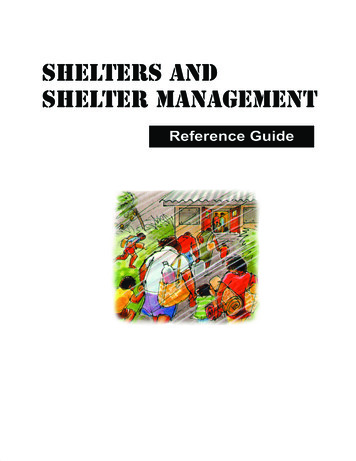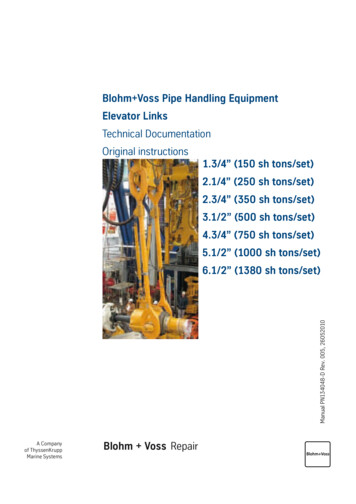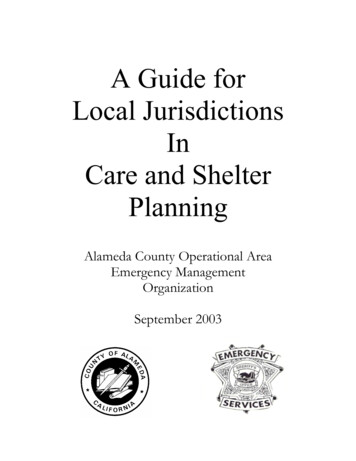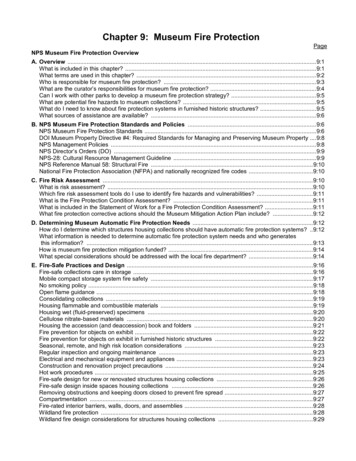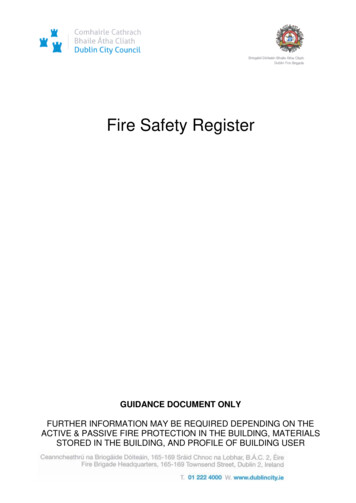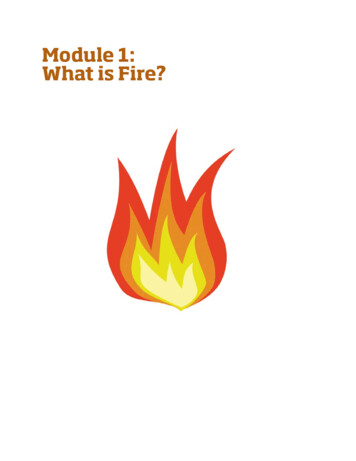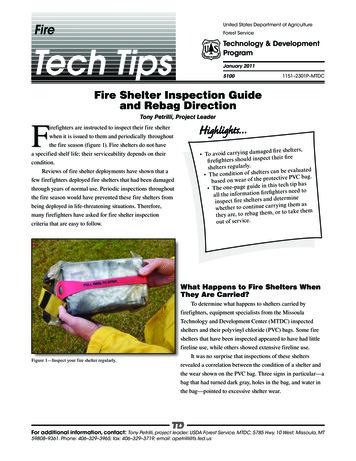
Transcription
FireUnited States Department of AgricultureForest ServiceTechnology & DevelopmentProgramJanuary 201151001151–2301P–MTDCFire Shelter Inspection Guideand Rebag DirectionFTony Petrilli, Project Leaderirefighters are instructed to inspect their fire shelterwhen it is issued to them and periodically throughoutthe fire season (figure 1). Fire shelters do not havea specified shelf life; their serviceability depends on theircondition.Reviews of fire shelter deployments have shown that afew firefighters deployed fire shelters that had been damagedthrough years of normal use. Periodic inspections throughoutthe fire season would have prevented these fire shelters frombeing deployed in life-threatening situations. Therefore,many firefighters have asked for fire shelter inspectioncriteria that are easy to follow.ged fire shelters, To avoid car ryi ng damact their firepeinsfirefig hters should.shelters reg ularlyrs can be evaluated The condition of sheltetective PVC bag.based on wear of the prothis tech tip has The one-page guide inhters need toall the information firefigdeterm ineinspe ct fire shelters andrying them aswhether to continue caror to take themthey are, to rebag the m,out of ser vic e.What Happens to Fire Shelters WhenThey Are Carried?Figure 1—Inspect your fire shelter regularly.To determine what happens to shelters carried byfirefighters, equipment specialists from the MissoulaTechnology and Development Center (MTDC) inspectedshelters and their polyvinyl chloride (PVC) bags. Some fireshelters that have been inspected appeared to have had littlefireline use, while others showed extensive fireline use.It was no surprise that inspections of these sheltersrevealed a correlation between the condition of a shelter andthe wear shown on the PVC bag. Three signs in particular—abag that had turned dark gray, holes in the bag, and water inthe bag—pointed to excessive shelter wear.For additional information, contact: Tony Petrilli, project leader; USDA Forest Service, MTDC; 5785 Hwy. 10 West; Missoula, MT59808–9361. Phone: 406–329–3965; fax: 406–329–3719; email: apetrilli@fs.fed.us1
A PVC bag turns dark gray when aluminum rubs offthe shelter onto the PVC bag. The more aluminum that hasbeen rubbed off, the more likely it is that the shelter may bedamaged. Simply carrying a fire shelter over the course of afire season could cause this kind of damage.Holes in the PVC bag allow debris (ash, dirt, sand, orwater) into the bag. Debris inside the bag abrades the shelter’souter layers. Large holes or many small holes in the PVC bagmake it more likely that debris will damage the shelter.A white film or dust on the aluminum foil is a sign ofcorrosion, indicating that water entered the PVC bag. A fireshelter with corrosion may be difficult to shake open duringdeployment. Water also may break down the bonds betweenthe aluminum foil, silica, and fiberglass cloth (figure 2).Figure 2—Fire shelters have two layers—the outer layer is silica laminatedto aluminum foil, the inner layer is fiberglass laminated to aluminum foil.In some cases, the PVC bags had worn out, but theshelters inside were still serviceable. Two actions can betaken to address this issue:1. Replace the carrying cases if needed. The blue nylonduck carrying cases and the hard plastic liners havebeen redesigned (September 2009). They are nowtaller and the carrying case’s cap is more secure.The flap on the fire shelter sleeve of the blue firelinepack is also more secure. These changes reduce thewear and tear on shelters. The updated fireline pack,carrying case, and plastic liner are available throughthe GSA “Wildland Fire Equipment Catalog”:o Fire Shelter Carrying Case, NSN: 8465-01-49831902o Fire Shelter Carrying Case Liner, NSN: 8465-01498-3191o Fireline Pack, NSN: 8465-01-503-4488o Fireline Pack (Complete), NSN: 8465-01-50344842. Rebag the shelters if needed. Use the “Fire ShelterInspection Guide” included in this tech tip todetermine whether a shelter is serviceable for fire use,should be rebagged, or should be taken out of service.Shelters that:o Show evidence of moisture inside the bag (waterdrops, condensation, or corrosion) should be takenout of service.o Have so much aluminum rubbed off that the paperlabel inside the bag is not readable should betaken out of service.o Have already been through the 2004 fire shelterrecall, retrofit, and rebagging (label is markedwith a red “R”) or have been previously rebagged(yellow rebag label is inside the PVC bag) shouldnot be rebagged a second time.Rebagging can prolong the useful life of a fire shelter.Two fire shelter manufacturers and one fire shelter PVC bagmanufacturer can be used for rebagging fire shelters. Eachlocal unit is responsible for making arrangements to have itsfire shelters rebagged.Each shelter must be assessed using the inspection guidebefore it is sent for rebagging. DO NOT REBAG FIRESHELTERS THAT DO NOT MEET THE INSPECTIONGUIDE CRITERIA FOR REBAGGING. If a fire shelterneeds to be taken out of service, take it out! For moreinformation about rebagging fire shelters, contact one of thefollowing: Anchor Industries Inc., in Evansville, INWeb site: http://www.anchorinc.com/Phone: 812–867–2421 Freedom Manufacturing LLC, in Saratoga Springs, NYWeb site: http://www.freedommfg.com/Phone: 518–584–0441 Weckworth Manufacturing, Inc., in Haysville, KSWeb site: http://www.weckworth.comPhone: 800–533–8368
Fire Shelter Inspection GuideShelter ConditionInspection CriteriaGray on the inside surface of the PVC bag (see C) is caused bythe aluminum foil rubbing off.1. A moderate to heavy gray PVC bag (see D) indicatespossible damage.2. Large holes or many small holes in the PVC bag indicatethat debris may have entered.3. Shelters in condition 1 or 2 that were previously recalled(red “R” on white label, see F) or rebagged (yellow rebaglabel, see G) should be taken out of service.Yellow letters correspond to the photoson the back of this guideAMoisture in bagYESNOEvaluate holesEvaluate PVC bagEBYESPVC bagclearYESREBAGPOSSIBLEFYESPVC baglight to moderategray, labelreadableRETURNTOSERVICENONOCYES0 to 3 holes lessthan inchRed “R” on whitelabelNOYESGYESYellow rebaglabelNO4 to 5 holes, lessthan inchNODNOPVC bag moderateto heavy gray, labelunreadableH1 to 3 holes,less than 1inchYESOUT OFSERVICEYESNO3
EASmallholeWaterdropletFB“R” Largeholes4
Use Out-of-Service Shelters for FireShelter TrainingFire shelters that are taken out of service should bemarked and used for practice deployments. Training shelters,although excellent training tools, do not act exactly as a realfire shelter—tearing open the PVC bag, shaking it out, andbeing inside one can feel different than a real fire shelter. Clearly mark shelters “OUT OF SERVICE—FORTRAINING ONLY” (figure 3). Practice shelter deployments in a high-stressenvironment, with time constraints, and in differentpositions (standing, kneeling, and lying down). NEVER practice shelter deployments in an actualfire—it’s not worth the risk of injury.Remember, inspect your fire shelter when it is issued toyou and every couple of weeks during the fire season. Inspectyour fire shelter if something out of the ordinary happens—for instance, if your fire shelter is submerged in water orexposed to a heavy rain storm, if your fire shelter falls from atruck or high shelf, or if your pack rolls down a hill.Figure 3—Mark fire shelters that are taken out of service to identify them as training shelters for practice deployments.35
About the AuthorsTony Petrilli is an equipment specialist for the fire and aviation and safety and health programs at MTDC. He has abachelor’s degree in education from Western Montana College. Petrilli began working for the Forest Service in 1982 andjoined MTDC full time in 2000. He has worked as a firefighter for the Lewis and Clark and Beaverhead National Forests andas a smokejumper for the Northern Region. He is a division/group supervisor, type III incident commander, and has servedon more than 20 fire entrapment review or investigation teams.Library CardPetrilli, Tony. 2011. Fire shelter inspection guide and rebag direction. Tech Tip 1151–2301P–MTDC. Missoula, MT: U.S.Department of Agriculture, Forest Service, Missoula Technology and Development Center. 4 p.This tech tip explains how to inspect fire shelters and the polyvinyl chloride (PVC) bags that protect them. Threesigns—a dark gray color of the PVC bag, holes in the bag, and water in the bag—point to excessive shelter wear. A 1-pageguide is included to help firefighters decide whether a shelter is still serviceable, whether it can be rebagged for fireline use,or whether the shelter needs to be taken out of service.Keywords: deployments, equipment, fire, inspections, New Generation fire shelter, PPE, PVC, quality control, safety atwork, training, wildland fire fighting, wildland firefightingAdditional single copies of this document may beordered from:USDA Forest Service, Missoula Technology andDevelopment Center5785 Hwy. 10 WestMissoula, MT 59808–9361Phone: 406–329–3978Fax: 406–329–3719Email: wo mtdc pubs@fs.fed.usFor additional information about fire shelterinspections and rebagging direction, contact Tony Petrilliat MTDC:Phone: 406–329–3965Fax: 406–329–3719Email: apetrilli@fs.fed.usElectronic copies of MTDC’s documents are availableon the Internet at:http://www.fs.fed.us/t-d andhttp://www.fs.fed.us/eng/pubs/Forest Service and Bureau of Land Managementemployees can search a more complete collection ofMTDC’s documents, CDs, DVDs, and videos on theirinternal computer networks at:http://fsweb.mtdc.wo.fs.fed.us/search/The Forest Service, United States Department of Agriculture (USDA), has developed this information for the guidance of its employees, its contractors, and its cooperating Federal and State agencies and isnot responsible for the interpretation or use of this information by anyone except its own employees. The use of trade, firm, or corporation names in this document is for the information and convenience of thereader and does not constitute an endorsement by the Department of any product or service to the exclusion of others that may be suitable.The U.S. Department of Agriculture (USDA) prohibits discrimination in all its programs and activities on the basis of race, color, national origin, age, disability, and where applicable, sex, marital status, familialstatus, parental status, religion, sexual orientation, genetic information, political beliefs, reprisal, or because all or part of an individual’s income is derived from any public assistance program. (Not all prohibitedbases apply to all programs.) Persons with disabilities who require alternative means for communication of program information (Braille, large print, audiotape, etc.) should contact USDA’s TARGET Center at(202) 720-2600 (voice and TDD). To file a complaint of discrimination, write to USDA, Director, Office of Civil Rights, 1400 Independence Avenue, S.W., Washington, D.C. 20250-9410, or call (800) 795-3272(voice) or (202) 720-6382 (TDD). USDA is an equal opportunity provider and employer.46
damaged. Simply carrying a fire shelter over the course of a fire season could cause this kind of damage. Holes in the PVC bag allow debris (ash, dirt, sand, or water) into the bag. Debris inside the bag abrades the shelter's outer layers. Large holes or many small holes in the PVC bag make it more likely that debris will damage the shelter.

